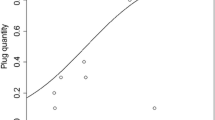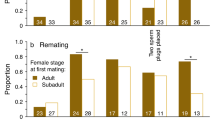Abstract
An obvious means to secure paternity is the production of a mating plug that blocks the female genital opening after mating. Although the mechanical efficacy and persistence of plugs on/in the female genital openings are key traits that determine the degree of paternity protection, these factors have hardly been explored. We therefore investigated the influence of the size of the amorphous plug material (experimentally terminated mating duration as a proxy) and age of the mating plug (time interval between copulations with two successive males) on the efficacy of the plug by analysing the mating success of subsequent males in the dwarf spider Oedothorax retusus (Linyphiidae: Erigoninae). Overall, subsequent males attempted to mate in 82 % of trials but only 32.5 % of these resulted in copulation, demonstrating that the plugs are effective safeguards against remating. Remating probability was significantly higher after previous short copulations (~small plug size) compared to long copulations (~large plug size). In the small plug group, fresh plugs (short remating intervals) were significantly less effective compared to older plugs. In the large plug group, remating probability was similarly low over all remating intervals. The observed copulations, however, do not necessarily result in sperm transfer, since sperm masses were found on the plugged female genital area. Our study on O. retusus shows that mating plugs are a powerful mechanical safeguard whose efficacy varies with plug size and age. We discuss these findings in the light of theoretical considerations on the evolution of effective mating plugs.


Similar content being viewed by others
References
Aisenberg A, Barrantes G (2011) Sexual behavior, cannibalism, and mating plugs as sticky traps in the orb weaver spider Leucauge argyra (Tetragnathidae). Naturwissenschaften 98:605–613
Aisenberg A, Eberhard WG (2009) Female cooperation in plug formation in a spider: effects of male copulatory courtship. Behav Ecol 20:1236–1241
Andersson J, Borg-Karlson AK, Wiklund C (2003) Antiaphrodisiacs in pierid butterflies: a theme with variation! J Chem Ecol 29:1489–1499
Austad SN (1984) Evolution of sperm priority patterns in spiders. In: Smith RL (ed) Sperm competition and the evolution of mating systems. Academic Press, San Diego, pp 223–249
Avila FW, Sirot LK, LaFlamme BA, Rubinstein CD, Wolfner MF (2011) Insect seminal fluid proteins: identification and function. Annu Rev Entomol 56:21–40
Birkhead TR, Møller AP (1998) Sperm competition and sexual selection. Academic Press, London
Colonello NA, Hartfelder K (2005) She’s my girl—male accessory gland products and their function in the reproductive biology of social bees. Apidologie 36:231–233
Diesel R (1990) Sperm competition and reproductive success in the decapod Inachus phalangium (Majidae): a male ghost spider crab that seals off rivals’ sperm. J Zool 220:213–223
Eberhard WG (2004) Why study spider sex: special traits of spiders facilitate studies of sperm competition and cryptic female choice. J Arachnol 32:545–556
Eberhard WG (2009) Postcopulatory sexual selection: Darwin’s omission and its consequences. Proc Natl Acad Sci 106:10025–10032
Elgar MA (1998) Sperm competition and sexual selection in spiders and other arachnids. In: Birkhead TR, Møller AP (eds) Sperm competition and sexual selection. Academic Press, London, pp 307–339
Fromhage L (2011) Mating unplugged: a model for the evolution of mating plug (dis-)placement. Evolution 66–1:31–39
Gack C, Peschke K (1994) Spermathecal morphology, sperm transfer and a novel mechanism of sperm displacement in the rove beetle, Aleochara curtula (Coleoptera, Staphylinidae). Zoomorphology 114:227–237
Herberstein ME, Wignall AE, Nessler SH, Harmer AMT, Schneider JM (2012) How effective and persistent are fragments of male genitalia as mating plugs? Behav Ecol 23:1140–1145
Huber BA, Senglet A (1997) Copulation with contralateral insertion in entelegyne spiders (Araeneae: Entelegynae: Tetragnathidae). Neth J Zool 47:99–102
Jackson RR (1980) The mating strategy of Phidippus johnsoni (Araneae, Salticidae): II. Sperm competition and the function of copulation. J Arachnol 8:217–240
Kuntner M, Gregorič M, Zhang S, Kralj-Fišer S, Li D (2012) Mating plugs in polyandrous giants: which sex produces them, when, how and why? PLoS ONE 7:e40939. doi:10.1371/journal.pone.0040939
Kunz K, Garbe S, Uhl G (2012) The function of the secretory cephalic hump in males of the dwarf spider Oedothorax retusus (Linyphiidae: Erigoninae). Anim Behav 83:511–517
Masumoto T (1993) The effect of the copulatory plug in the funnel-web spider, Agelena limbata (Araneae: Agelenidae). J Arachnol 21:55–59
Matsumoto K, Suzuki N (1992) Effectiveness of the mating plug in Atrophaneura alcinous (Lepidoptera, Papilionidae). Behav Ecol Sociobiol 30:157–163
Miller JA, Hormiga G (2004) Clade stability and the addition of data: a case study from erigonine spiders (Araneae: Linyphiidae, Erigoninae). Cladistics 20:385–442
Mulisch M, Welsch U (2010) Romeis - Mikroskopische Technik. Spektrum Akademischer Verlag, Heidelberg
O’Donnell RP, Ford NB, Shine R, Mason RT (2004) Male red-sided garter snakes (Thamnophis sirtalis parietalis) determine female mating status from pheromone trails. Anim Behav 68:677–683
Orr AG, Rutowski RL (1991) The function of the sphragis in Cressida cressida (Fab) (Lepidoptera, Papilionidae): a visual deterrent to copulation attempts. J Nat Hist 25:703–710
Parker GA (1970) Sperm competition and its evolutionary consequences in the insects. Biol Rev 45:525–567
Parker GA (1998) Sperm competition and the evolution of ejaculates: towards a theory base. In: Birkhead TR, Møller AP (eds) Sperm competition and sexual selection. Academic Press, London, pp 3–54
Polak M, Wolf LL, Starmer WT, Barker JSF (2001) Function of the mating plug in Drosophila hibisci Bock. Anim Behav 49:196–205
Richter N (2006) Zur Funktion der Kopfsekrete männlicher Zwergspinnen. Diploma thesis, University of Bonn
Schlechter-Helas J, Schmitt T, Peschke K (2011) A contact anti-aphrodisiac pheromone supplied by the spermatophore in the rove beetle Aleochara curtula: mode of transfer and evolutionary significance. Naturwissenschaften 98:855–862
Schulz S, Estrada C, Yildizhan S, Boppré M, Gilbert LE (2008) An antiaphrodisiac in Heliconius melpomene butterflies. J Chem Ecol 34:82–93
Shine R, Olsson MM, Mason RT (2000) Chastity belts in gartersnakes: the functional significance of mating plugs. Biol J Linn Soc 70:377–390
Simmons LW (2001) Sperm competition and its evolutionary consequences in the insects. Princeton University Press, Princeton
Simmons LW, Siva-Jothy MT (1998) Sperm competition in insects: mechanisms and the potential for selection. In: Birkhead TR, Møller AP (eds) Sperm competition and sexual selection. Academic Press, London, pp 341–434
Uhl G, Busch M (2009) Securing paternity: mating plugs in the dwarf spider Oedothorax retusus (Araneae: Erigoninae). Biol J Linn Soc 96:574–583
Uhl G, Kunz K, Vöcking O, Lipke E (2014) A spider mating plug: origin and constraints of production. Biol J Linn Soc, in press
Uhl G, Nessler SH, Schneider JM (2010) Securing paternity in spiders? A review on occurrence and effects of mating plugs and male genital mutilation. Genetica 138:75–104
Wedell N (2005) Female receptivity in butterflies and moths. J Exp Biol 208:3433–3440
Acknowledgments
We thank Rabea Schlüter (Imaging Centre University of Greifswald) for expert introduction to the SEM microscope. We thank Lara Lopardo, Michael Schmitt, the editor Mark Elgar and three anonymous reviewers for their constructive comments, which helped us to improve the manuscript. The experiments comply with the current laws of Germany.
Conflict of interest
The authors declare that there is no conflict of interest.
Author information
Authors and Affiliations
Corresponding author
Additional information
Communicated by M. Elgar
Rights and permissions
About this article
Cite this article
Kunz, K., Witthuhn, M. & Uhl, G. Do the size and age of mating plugs alter their efficacy in protecting paternity?. Behav Ecol Sociobiol 68, 1321–1328 (2014). https://doi.org/10.1007/s00265-014-1742-7
Received:
Revised:
Accepted:
Published:
Issue Date:
DOI: https://doi.org/10.1007/s00265-014-1742-7




